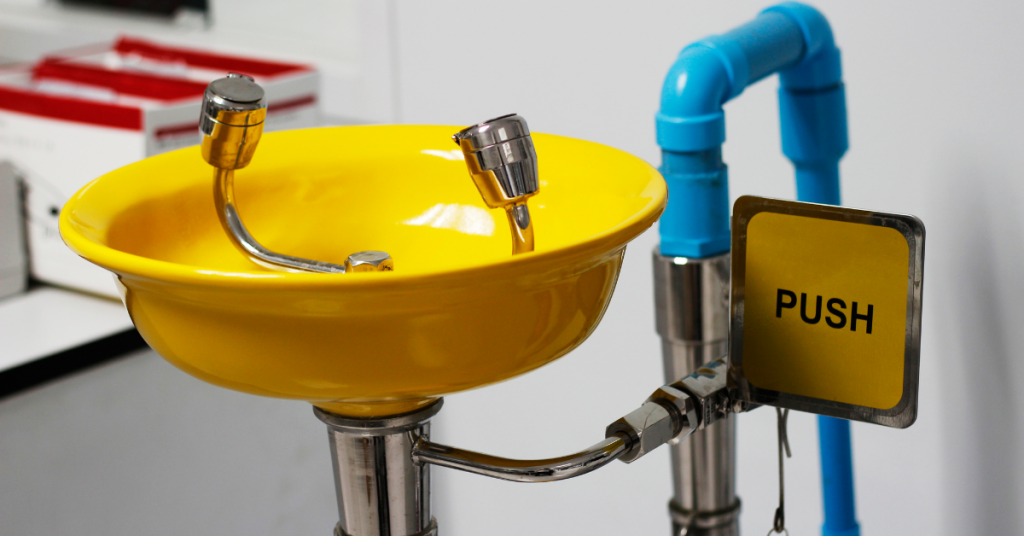When working in environments where chemicals, dust, or harmful liquids are used, there’s always a chance that something might splash or spill into someone’s eyes. It can happen in a lab, a factory, a cleaning room, or even a warehouse. That’s why every site like this needs an eye wash station installed nearby.
The goal of the station is simple, flush out the eye fast, with clean water, before more damage happens. If someone gets exposed to a chemical or substance, even a few seconds can make a difference.

What Is an Eye Wash Station?
An eye wash station is a safety device that sends a stream of water directly to the eyes. It usually has two nozzles that spray gently, allowing both eyes to be rinsed at the same time. The person leans forward, opens their eyes wide, and lets the water flow to remove the irritant.
Some units are fixed to a wall or stand. Others are portable and use bottles or gravity-fed tanks. The main idea is that anyone can reach it fast without needing help.
Where to Install Eye Wash Stations
The location of an eye wash unit is critical. It must be close to the area where the hazard exists. For example, if there’s a chemical mixing table, the station must be nearby. If there’s spray equipment in use, or large tanks being cleaned, there should be one in that area too.
No one should have to run up stairs or through doors just to reach help. Ideally, a person should be able to reach the eye wash station within 10 seconds. That’s often the difference between mild irritation and permanent damage.
Keeping Eye Wash Stations Clean
Like all safety equipment, these stations must be cleaned and checked often. Water lines can build up dirt or bacteria. Bottled units can expire. Units must be flushed regularly to make sure they work and the water is clean.
If a unit is out of order or blocked, it’s useless in an emergency. Assign someone to check the units every week. Remove dust, clean nozzles, and test the water flow. This doesn’t take long, but it could help save someone’s eyesight.
Training People to Use It Properly
It’s one thing to install an eye wash unit. It’s another to make sure people know how to use it. Every worker in a high-risk area must be shown where it is, how to turn it on, and how to use it. Even people who don’t work with chemicals directly might need it if something spills nearby.
Training should cover how to hold the eyes open, how long to rinse, and what to do next. In many cases, people are told to rinse for at least 15 minutes and then go to a clinic or call for medical help.
The Role of Eye Wash Stations in Emergency Plans
A good emergency plan includes evacuation routes, first aid kits, and contact numbers. It should also include eye wash stations. If someone calls for help, others should know how to lead them to the station or guide them through using it.
Some sites put a checklist near the unit. Others use bold labels and safety signs so the station can be seen from a distance. This helps people find it fast, even if they are in pain or panicking.
Eye Wash Stations Are Not Only for Chemicals
While most people think of these units as protection against acid or strong cleaners, they are also used in areas with dust, smoke, or flying debris. Even a fine powder or metal shaving can hurt the eye.
In building sites, carpentry rooms, and auto shops, particles often go airborne. A rinse with clean water is the best way to remove anything sharp or irritating from the surface of the eye.
Keeping Spare Bottles Helps
Some sites add a small bottle-based station in high-risk areas. These are easier to carry and can help until the person reaches a full-size unit. While these are not a replacement for a full eye wash station, they are useful in mobile units, trucks, and small rooms.
Make sure bottles are sealed, clean, and still within their expiry date. Like any first aid item, they should be replaced if they’ve been used or are no longer sterile.
Final Thoughts
Eye wash stations are a must-have in any space where there’s a risk to the eyes. A few seconds can make the difference between full recovery and permanent harm. Installing the unit is just the first step. Keeping it clean, testing it often, and training workers to use it, those are the parts that really matter. Safety isn’t just about having equipment. It’s about knowing what to do when something goes wrong.